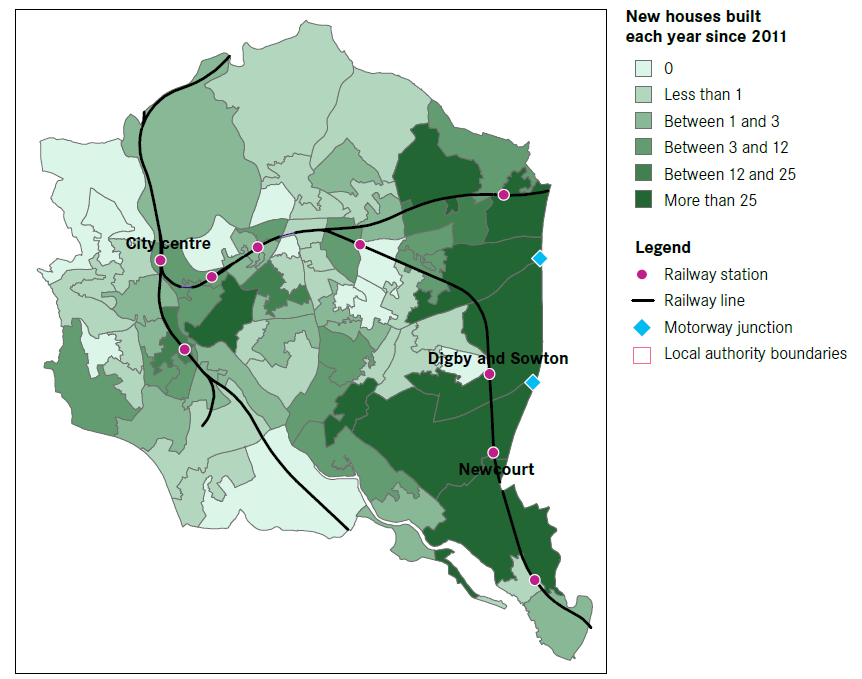The UK has entered and will leave this pandemic while experiencing a decades-long housing shortage. The country will soon begin to repair the harm done to the economy and society by this disease, but it cannot continue to afford this housing crisis. The inequality it fuels and the damage it causes to national and local economies are too great to bear. We cannot go back to how things were before.
At its core, ending the housing shortage requires more homes. But where new homes are built matters. Yet at present, not enough houses are built in some cities, and arguably too many are built in others. This mismatch emerges as the design of the planning system means it rations the supply of land available for new homes. Ending the housing crisis will therefore require reform of the green belt and a new, flexible zoning planning system to build enough new homes.
The housing crisis is local, not national
The reason why the planning system is so important can be found in the geography of the housing shortage. Some cities have far greater affordability problems than others. For example, while in 2019 the average house in Barnsley cost 5.3 times the local average income, in Brighton that ratio rose to 13.5 times local average incomes. Despite their higher average wages, prosperous cities such as York and Bristol are generally less affordable than places with struggling economies and lower wages such as Dundee or Blackpool.
So solving the housing crisis therefore requires a focus on the most expensive cities with the worst affordability problems. But currently, as Fig. 1 below shows, there is no link between cities’ demand for housing and their supply of new homes. Many expensive cities including Oxford and Bournemouth are building far fewer homes than those which are more affordable such as Wakefield or Telford. The supply and demand of new homes have been disconnected.

The planning system disconnects local housing supply from local demand
This decoupling of supply from demand originates in the planning system, as the amount of land it makes available for housing is rationed. Development of new homes normally cannot proceed unless the council decides at their discretion to grant a planning permission to a site. Measures such as the green belt block new homes across large areas of land adjacent to many cities and railway stations, including Bristol, Newcastle, Manchester, Birmingham, and London.
The rationing of land, not prices or affordability or need, ultimately decides how many houses cities build. It explains why some cities which have low demand build more than the average city, and far more than some very unaffordable cities.
The planning system prevents redevelopment in large parts of the existing suburbs
The planning system’s rationing of land can be seen in how it warps the supply of new homes within cities. Consider Exeter, an expensive city which is building lots of new homes above the average rate for cities, in Fig.2 below. A substantial number of homes have been built in the city centre (8 per cent growth since 2011), and there is a cluster of new homes being built on the eastern outskirts of the city, including near the brand new railway station of Newcourt.
Fig. 2 Housing supply in Exeter from 2011-2019

Nevertheless, 48 per cent of suburban neighbourhoods in Exeter are building less than one house a year. 14 per cent of suburban neighbourhoods in Exeter have actually built no new houses over this period, including a built-up area close to Digby & Sowton station. Even though Exeter has built lots of new houses, the amount of land which has been made available for development has still been subject to rationing.
These dormant suburbs which make little or no contribution to new housing supply are not unique to Exeter. 51 per cent of all suburban neighbourhoods in England and Wales built less than one house a year, or zero, from 2011-2019, providing only 2 per cent of all new suburban homes over that period.
This national pattern across cities emerges from the design of the planning system. As the supply of new homes is controlled by the discretionary granting of planning permissions by elected councillors, it is both uncertain for developers to navigate and sensitive to political pressure from anti-housing activists. The result is that as so much of the suburbs and unremarkable green belt land are off-limits to new homes, new housing supply is forced into easy-to-develop pockets on the outskirts of cities, and pressure for redevelopment is put on city centres and locations such as social housing estates and offices into flats.
Local shortages which emerge from the planning system make inequality worse within and between cities
By stunting the supply of housing in expensive cities, the planning system creates two different inequalities.
First, it drives inequality in housing costs within prosperous cities between renters and homeowners. As rents rise due to the shortage of homes, so does the wealth of homeowning neighbours as through their housing equity.
Second, it drives inequality in housing wealth between homeowners in more prosperous and weaker economies. From 2013-18, average housing equity per house in Brighton rose by £83,000 – but in Doncaster it rose by just £5,000. By preventing new homes from being built in the most expensive cities to stabilise local prices, the planning system reinforces economic inequality in them and across the country.
Ending the housing crisis requires a new flexible zoning system for planning
Solving the housing crisis and tackling these issues requires reconnecting local supply to local demand, and that entails reform of the planning system. Green belt reform is one area where this is needed, and Centre for Cities have calculated that 1.7 to 2.1 million new homes could be built on less than 2 per cent of the green belt within walking distance of railway stations outside Bristol, Newcastle, Birmingham, Manchester and London.
More building by councils and housing associations can play a large role here. However, the root cause of the housing crisis lies not in a specific lack of social housing but in the institutional design of the planning system. For instance, England still has one of the largest social housing sectors in Europe, at 17 per cent of all housing stock, yet it also has one of the continent’s most dire housing crises.
Ultimately, the design of the planning system must change. Building more homes in the most expensive cities will require a shift from its discretionary model towards a flexible zoning system, as in Japan and certain US cities.
This approach, where planning permission legally must be granted if a proposal complies with a national zoning code and national building regulations to ensure the structures are safe, is compatible with more social and council housing. But it would fix the institutional problems the private sector faces by reconnecting local supply to local demand, and end the housing crisis by building more homes in the least affordable places with the greatest need.

